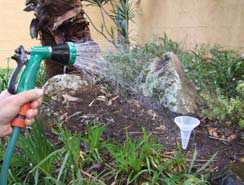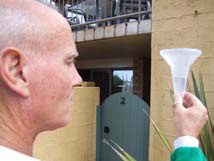MEASURE HOW MUCH WATER YOU USE ON YOUR GARDEN WITH THE CAPEABILITY CATCH CAN
Contact Jeremy for more information
What is it for?
It is specially made to measure the water put on plants by hand watering or irrigation systems.
If you look carefully at the can you will see there are two scales on IT; one on each side. One scale measures the volume of water collected in millilitres (mL) and the other measures the depth of water in millimetres (mm).
When we are measuring the amount of water we put on the garden we use millimetres (mm). The amount of water applied is referred to as the “depth of irrigation”.
How much did I use?
Place your catch can next to the plants you are watering so that it catches water as you apply it. Take a note of the time and then water your plants as you would normally. When you have finished watering make a note of how long you watered the plants for.
 |
 |
When you have done this pick up your catch can and look for the millimetre (mm) scale. Hold the can, making sure it is level and, using the mm scale, see how much water has been collected. You can now work out how much your system puts on each minute.
 |
Example to work out how much you use
Jane waters her garden for fifteen minutes and collects water in her catch can. She reads the scale and sees that she has collected 5 mm of water in 15 minutes. To work out the rate at which she applies water she does the following sum:
| mm collected
Time of collection |
X 60 = mm per hour |
She calculates that her system applies 5 mm divided by 15 minutes which is approximately 20 mm per hour ( 5/15 x 60 = 20).
How long should I water?
The length of time you water your plants depends on a few things, the most important of which are the plants you are watering, the soils they are growing in and where you live. The climate of the place where you live will determine the amount of water the plants will require to survive. The table below gives an indication of the amount of water in millimetres that you need in some of the major cities in Australia. It is important to remember that this is just a guide and that it is a good idea to watch your daily weather forecasts.
To use the table look for your city and read the value for the month you wish to water your plants in. As an example if we look in the Sydney column and the August row we can see that the weekly water demand is 0 mm. This means under normal conditions we would not expect to water lawns in this month. In contrast the water required in January is estimated at 17mm per week in Sydney or nearly 1 inch in the old scale. Droughts and very wet weather will change the water requirement a lot and it is important to remember that, while these estimates are based on data from the Bureau of Meteorology, they are only estimates. With this guide as a starting point and by watching the weather you will be able to work out how much water to put on your garden.
Approximate weekly plant water demand for lawns (mm) for each month
| Brisbane | Sydney | Melbourne | Hobart | Adelaide | Perth | Darwin | |
|---|---|---|---|---|---|---|---|
| January | 24 | 17 | 15 | 15 | 21 | 24 | 24 |
| February | 19 | 17 | 13 | 13 | 17 | 19 | 21 |
| March | 18 | 15 | 13 | 11 | 15 | 16 | 27 |
| April | 13 | 11 | 9 | 6 | 9 | 11 | 23 |
| May | 0 | 0 | 0 | 0 | 0 | 0 | 0 |
| June | 0 | 0 | 0 | 0 | 0 | 0 | 0 |
| July | 0 | 0 | 0 | 0 | 0 | 0 | 0 |
| August | 0 | 0 | 0 | 0 | 0 | 0 | 0 |
| September | 13 | 11 | 9 | 8 | 10 | 13 | 21 |
| October | 19 | 15 | 13 | 13 | 15 | 18 | 26 |
| November | 21 | 19 | 15 | 14 | 16 | 20 | 26 |
| December | 24 | 21 | 17 | 16 | 21 | 23 | 28 |
Note: If you put one 10 litre bucket of water over an area measuring 1m by 1m that is the equivalent of 10 mm of irrigation or rainfall.
